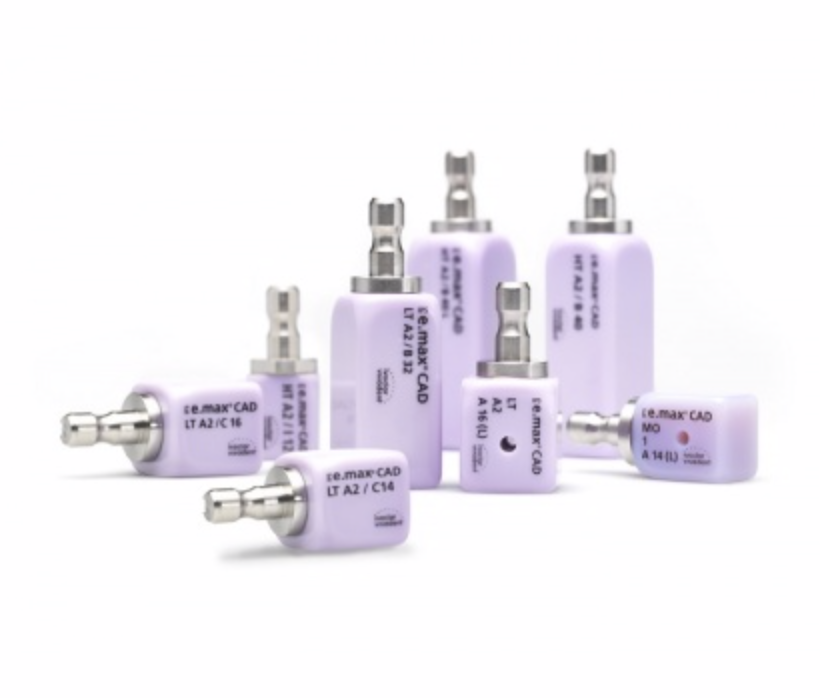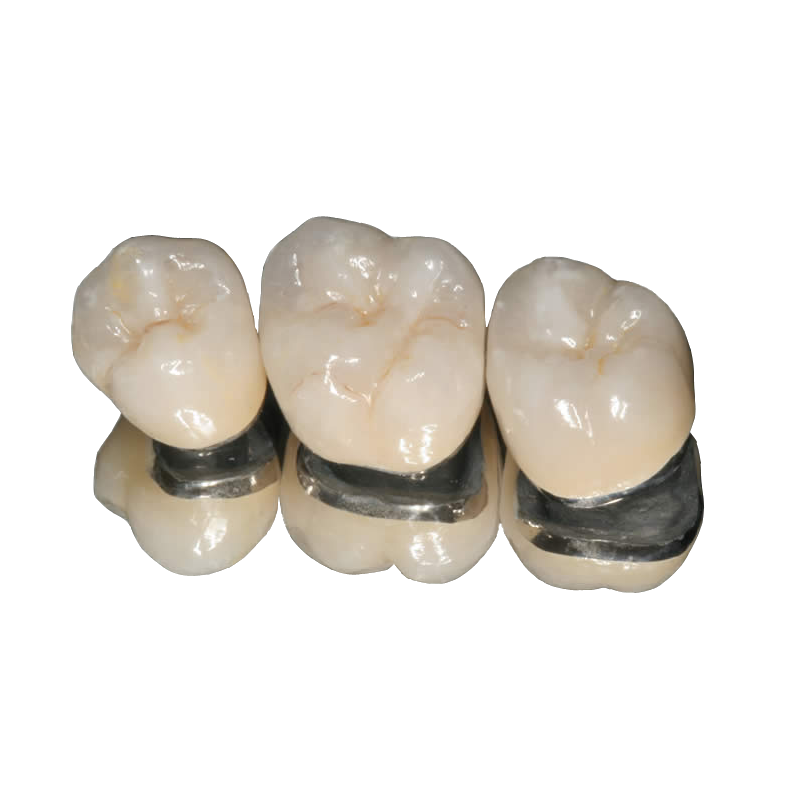FIXED
Balmoral Dental will work together with the dentist to offer the best possible solution that meets the requirements of the individual situation and the esthetic expectations.
We offer many types of fixed restorations in various materials.
- Veneers
- Crowns
- Dental Bridges
- Implants
We mill all our zirconia in-house. Having complete control of the process from end to end means we can set the standard and provide the highest quality zirconia restorations while maintaining the customization of design desired by our dentists. With esthetics that mimic natural teeth you can provide your patients with a monolithic metal free restoration economically.
Full Contour Zirconia
Milled in our laboratory to full contour and stained to your specifications
Indications
Full-contour zirconia is so versatile, it can be used in almost any situation from singles, bridges with any combination of abutments and pontics, inlay bridges and screw-retained implants. Also an esthetic alternative to a PFM with metal occlusion due to limited space.
Contraindications
When esthetic expectations are high and it is important that the restorations match surrounding natural dentition or other existing restorations. If bonding is necessary to retain the restoration, bond strength is weaker and less predictable than other ceramics.
Preparation
Shoulder preparation not needed. A mild chamfer or a feather-edge margin is good. 1mm buccal, lingual, and occlusal reduction is ideal, but can go to .5mm in some areas when reduction is limited. Minimum occlusal reduction of 0.5 mm; 1 mm is ideal. Adjustments and polishing: Adjust full-contour zirconia crowns and bridges using water and air spray to keep the restoration cool and to avoid microfractures with a fine grit diamond. If using air only, use the lightest touch possible when making adjustments. A football-shaped bur is the most effective for occlusal and lingual surfaces (on anterior teeth); a tapered bur is the ideal choice for buccal and lingual surfaces. Polish full-contour zirconia restorations with the porcelain polishing system of your choice.
Cementation
It is recommended that full-contour zirconia be cemented using a zirconia primer like Z-Prime from Bisco or Clearfil Ceramic Primer from Kuraray. Alternatively, a resin reinforced glass ionomer such as RelyX Luting cement can also be used. When a greater bond is needed due to the lack of a retentive preparation, use a resin cement like RelyX Unicam or RelyX Ultimate. Before cementing all full-contour zirconia crowns, the interior surface of the crown needs to be cleaned with Ivoclean (Ivoclar Vivadent – Amherst, NY). This is critical in assuring maximum bond strength.
Porcelain Fused to Zirconia
Veneered porcelain over our in lab milled zirconia substructure for the most translucent effect and highest aesthetic results.
Indications
A CAD/CAM substitute for traditional PFM, our porcelain-fused-to-zirconia can be used for anterior and posterior crowns, crowns over implants, and bridges of up to fourteen units.
Contraindications
- Attachment cases
- Cases with less than 1 mm clearance
- Bruxism
- Patients who have broken a PFM crown
- Cases that require bonding
Preparation
The ideal preparation for PFZs is a chamfer margin preparation. If a porcelain labial margin is prescribed, then a shoulder margin preparation is required.
Cementation
- Resin Ionomer cement (RelyX or RelyX Unicem, 3M ESPE)
- Maxcem Elite (Kerr)
- Panavia F 2.0 (Kuraray) – ideal for short, tapered preparations
- Glass ionomer cement (GC Fuji, GC America)
![]()
Highlights
- Unparalleled Translucency
- High Strength and Durability
- Suitable for anterior or posterior bridges Up to 3 Units
- 100% Digitally manufactured in lab
- Conventional cementation Zirconia

e.max® Press is best suited for high esthetics in the Anterior with properties that mimic natural enamel in translucency.
Available by either the stained or cutback technique to meet your patients specific esthetic desires.
Our layering technique displays a highly esthetic three dimensional effect for a natural looking restorations while our stain technique offers an economical option and a minimally invasive restoration.
Highlights
- Highly esthetic
- Precision fit, form & function
- Layered or Stained
- Higher aesthetics for conservative preparations
Advantages
- Proven, high-strength material for long-lasting clinical results; flexible cementation options
- Lifelike esthetics, regardless of the shade of the prepared tooth
- Polychromatic Multi ingots for utmost efficiency
- Five levels of translucency and additional Impulse ingots for maximum flexibility
- Minimally invasive, accurately fitting restorations
- Adhesive, self-adhesive, or conventional cementation options depending on the indication
Indications
IPS e.max is the premium lithium disilicate, glass-ceramic restoration. Combining lifelike materials and fracture resistant properties, IPS e.max is as durable as it is lifelike. The flexibility of IPS e.max makes it an excellent restorative method for anterior esthetics or posterior function.
Contraindications
Bridges which include molars, Maryland style bridges, and bridges which have a short vertical height that does not allow for adequate connector height.
Preparation
Anterior full-coverage crowns require a chamfer or shoulder margin. A circular shoulder is prepared with rounded inner edges or a chamfer at an angle of 10-30°: the width of the shoulder/chamfer is approx. 1 mm. Facial reduction is 1.5 – 2 mm; 1 – 1.5 mm lingual contact clearance. Incisal reduction is 1.5 – 2 mm with rounded internal line angles, and an incisal edge at least 1mm wide to permit optimum milling of the incisal edge during CAD/CAM processing.
Posterior full-coverage crown requires a chamfer or shoulder margin. A circular shoulder is prepared with rounded inner edges or a chamfer at an angle of 10-30°: the width of the shoulder/chamfer is approx. 1 mm. Occlusal reduction is 1.5 – 2 mm: axial reduction (buccal, lingual, and interproximal) is 1.5 mm with rounded internal line angles.
Cementation
IPS e.max layered – can be cemented using a resin reinforced glass ionimer such as RelyX Luting cement. Or bonded using a resin cement when extra strength is needed due to lack of retention on the prep, use a resin cement such as RelyX Unicem or RelyX Ultimate.

This full contour Monolithic Solution is CAD designed and demonstrates high strength, durability and proven clinical properties.
Suitable for Veneers to 3 unit bridges and are available in different levels of translucency of the A-D shades.
Indications
- Thin veneers (0.4 mm)
- Veneers
- Occlusal veneers
- Inlays/Onlays
- Crowns
- Three-unit bridges (up to the second premolar as the terminal abutment)
- Minimally invasive crown preparation; adhesive cementation
- Milled in-house
Highlights
- High-strength lithium disilicate glass-ceramic (LS2) featuring a flexural strength of 360 MPa
- Excellent esthetics and optional customization
- Comprehensive indication range
- Extensive clinical evidence from long-term scientific studies
- Fast and efficient processing
- Clinically proven and versatile cementation options

Amazing chameleon effect provides in-vivo blending for perfect balance of translucency and natural opalescence (natural vitality). Natural-like opalescence reduces graying effect in the patient mouth giving an excellent VITA shade matching.
Fascinating esthetics unmatched.
Indications
- Single-tooth restorations (Inlays, onlays, veneers, anterior and posterior crowns and up to 3-unit anterior bridges)
Highlights
- Highly esthetic pressed restorations
- Excellent margin quality increase confidence in complex case designs
- Exceptional flexural strength >500 MPa
Situation to avoid:
Insufficient wall thickness.
Direct insertion without polishing or glazing.
Cutting blocks using non-compatible CAD/CAM system.
Use of stains and veneering materials by third-party manufacturers.
Use of auxiliary firing pastes by third-party manufacturers.
Use of tungsten carbide cutters.

The metal provides stability and strength, which makes it a strong contender against crowns made from alternative materials. The porcelain provides the restored tooth with a lifelike appearance. These crowns are still a popular option due to their high rate of clinical success and their biocompatibility that helps ensure continued periodontal health. PFMs are also gentle on opposing dentition. The use of CAD/CAM technology allows our clinicians to fabricate this traditional solution with extreme precision.
Indications
Our PFMs can be used for crowns and bridges (up to fourteen units). PFMs can be manufactured to nonprecious, semiprecious, and yellow high noble copings and can be used in conjunction with cast partials and implants.
Contraindications
Contraindicated when the patient has a metal allergy or when the size of the tooth pulp is negligibly smaller, thus compromising the tooth preparation process. It is also contraindicated when the clinical tooth crown is very short and lacks the required stability including retention that is enough to provide the space for porcelain and metal.
Preparation
The ideal preparation for PFMs is a chamfer margin preparation. If a porcelain labial margin is prescribed, then a shoulder margin preparation is required.
Cementation
- Panavia 21 – tin plated
- Glass ionomer cement (GC Fuji, GC America)
- Zinc Phosphate Polycarboxylate
- Resin Ionomer cement (RelyX, 3M ESPE)
Our all metal crowns are a good choice where minimal tooth reduction and superior strength is required.
Types of restoration design
- Inlays
- Onlays
- Full Crowns
- 3/4 Crowns
- Surveyed Crowns
- Bridges
- Retainers for FPD
Indications
Full-cast gold crowns are indicated for crowns, veneers, inlays, onlays, and bridges.
Contraindications
Full-cast gold crowns are contraindicated for partials and implants.
Preparation
Inlays and onlays can also be fabricated as a full-cast restoration. Feather-edge margin preparations are indicated for full-cast restorations, but any margin preparation may be used.
Cementation
- Panavia 21 (Must be tin plated if precious metal is used)
- Glass ionomer cement (GC Fuji, GC America)
- Zinc Phosphate Polycarboxylate Resin Ionomer cement (RelyX, 3M ESPE)
WHAT SHOULD I SEND IN A CASE?
- A complete lab slip
- Digital photographs
- Full arch master impression
- Opposing arch impression
- CO bite registration
Or Send us your Digital Scan
Types of dental intraoral files we accept:
- 3Shape TRIOS
- iTero Element
- Straumann CARES Scanner
- 3M True Definition Scanner
- CS 3600 Intraoral Scanner
- Omnicam (Dentsply-Sirona)
Have a difficult case? Contact us below for personal assistance.
Sault Ste Marie
Sault Ste Marie
Get In Touch
Contact Us
Thunder Bay
109 Algoma St S,
Thunder Bay, P7B 3B7
Thunder Bay Phone & Fax
807.683.0300
Sault Ste Marie
648 Bay St
Sault Ste Marie, P6A1X8
Sault Ste Marie Phone
Toll Free
Get In Touch
Contact Us
Thunder Bay
109 Algoma St S,
Thunder Bay, P7B 3B7
Thunder Bay Phone & Fax
807.683.0300
Sault Ste Marie
648 Bay St
Sault Ste Marie, P6A1X8
